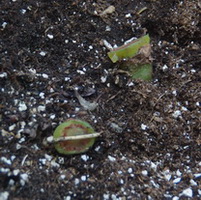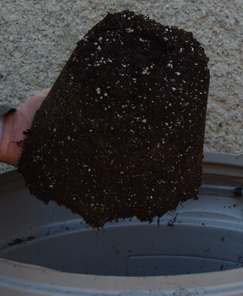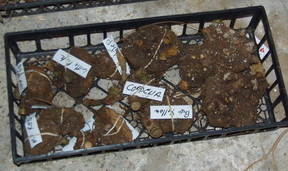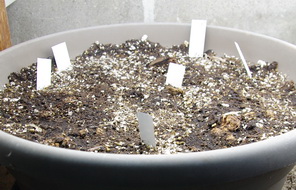|
Tuberous Begonia Winterizing
|

Remove Foliage Cut the stems just above the tops of the tubers and toss all of the sad looking stems, flowers and leaves into the compost heap.

Find the Tuber Remove the ball of soil from its pot and be surprised at how little root growth these large plants make over the summer. Gently remove as much of the soil as possible. I save this soil for reuse in other containers next year. Only remove the soil around the tuber that will come away with a gentle probing.

Let It Dry When winterizing tuberous begonias, I identify them , (little labels held on by elastics,) by name or colour and then place them in a single layer in a flat and leave them in a warm dry place for a few days. The rest of the soil around the tubers will dry out and can now be gently shaken off.
Store Them These tubers like to spend the winter in a cool, not cold, and dark location. They can be loosely packed in some barely moist peat moss or just left in the flat. Mine stay in a corner of a basement room that is about 10 - 12 C (50 - 55 F) and as dark as possible.
 Next Spring About mid March, try to remember the location you chose for your tuberous begonia winterizing and bring them out. I plant several in large shallow containers, water them and place them under my lights. When the shoots are 5 - 10 cm it’s time to separate them and put each one in its own pot. They will get transplanted into their summer containers when it is warm enough to move them outside.
Next Spring About mid March, try to remember the location you chose for your tuberous begonia winterizing and bring them out. I plant several in large shallow containers, water them and place them under my lights. When the shoots are 5 - 10 cm it’s time to separate them and put each one in its own pot. They will get transplanted into their summer containers when it is warm enough to move them outside.
return from Tuberous Begonia winterizing to containers main page
